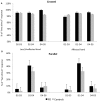Aristotle's illusion in Parkinson's disease: evidence for normal interdigit tactile perception
- PMID: 24523929
- PMCID: PMC3921216
- DOI: 10.1371/journal.pone.0088686
Aristotle's illusion in Parkinson's disease: evidence for normal interdigit tactile perception
Abstract
Sensory alterations, a common feature of such movement disorders as Parkinson's disease (PD) and dystonia, could emerge as epiphenomena of basal ganglia dysfunction. Recently, we found a selective reduction of tactile perception (Aristotle's illusion, the illusory doubling sensation of one object when touched with crossed fingers) in the affected hand of patients with focal hand dystonia. This suggests that reduced tactile illusion might be a specific feature of this type of dystonia and could be due to abnormal somatosensory cortical activation. The aim of the current study was to investigate whether Aristotle's illusion is reduced in the affected hand of patients with PD. We tested 15 PD patients, in whom motor symptoms were mainly localised to one side of the body, and 15 healthy controls. Three pairs of fingers were tested in crossed (evoking the illusion) or parallel position (not evoking the illusion). A sphere was placed in the contact point between the two fingers and the blindfolded participants had to say whether they felt one or two stimuli. Stimuli were applied on the affected and less or unaffected side of the PD patients. We found no difference in illusory perception between the PD patients and the controls, nor between the more affected and less/unaffected side, suggesting that Aristotle's illusion is preserved in PD. The retained tactile illusion in PD and its reduction in focal hand dystonia suggest that the basal ganglia, which are dysfunctional in both PD and dystonia, may not be causally involved in this function. Instead, the level of activation between digits in the somatosensory cortex may be more directly involved. Finally, the similar percentage of illusion in the more affected and less or unaffected body sides indicates that the illusory perception is not influenced by the presence or amount of motor symptoms.
Conflict of interest statement
Figures



Similar articles
-
Actual and Illusory Perception in Parkinson's Disease and Dystonia: A Narrative Review.Front Neurol. 2018 Jul 20;9:584. doi: 10.3389/fneur.2018.00584. eCollection 2018. Front Neurol. 2018. PMID: 30079051 Free PMC article. Review.
-
Aristotle's illusion reveals interdigit functional somatosensory alterations in focal hand dystonia.Brain. 2013 Mar;136(Pt 3):782-9. doi: 10.1093/brain/aws372. Epub 2013 Feb 11. Brain. 2013. PMID: 23404333
-
Parkinson's disease alters multisensory perception: Insights from the Rubber Hand Illusion.Neuropsychologia. 2017 Mar;97:38-45. doi: 10.1016/j.neuropsychologia.2017.01.031. Epub 2017 Jan 31. Neuropsychologia. 2017. PMID: 28153639
-
Impairment of the rubber hand illusion in focal hand dystonia.Brain. 2011 May;134(Pt 5):1428-37. doi: 10.1093/brain/awr026. Epub 2011 Mar 4. Brain. 2011. PMID: 21378099
-
The interaction between motion and texture in the sense of touch.J Neurophysiol. 2021 Oct 1;126(4):1375-1390. doi: 10.1152/jn.00583.2020. Epub 2021 Sep 8. J Neurophysiol. 2021. PMID: 34495782 Review.
Cited by
-
Actual and Illusory Perception in Parkinson's Disease and Dystonia: A Narrative Review.Front Neurol. 2018 Jul 20;9:584. doi: 10.3389/fneur.2018.00584. eCollection 2018. Front Neurol. 2018. PMID: 30079051 Free PMC article. Review.
References
-
- Schneider JS, Diamond SG, Markham CH (1987) Parkinson’s disease: sensory and motor problems in arms and hands. Neurology 37: 951–956. - PubMed
-
- Sathian K, Zangaladze A, Green J, Vitek JL, DeLong MR (1997) Tactile spatial acuity and roughness discrimination: impairments due to aging and Parkinson’s disease. Neurology 49: 168–177. - PubMed
-
- Sailer A, Molnar GF, Paradiso G, Gunraj CA, Lang AE, et al. (2003) Short and long latency afferent inhibition in Parkinson’s disease. Brain 126: 1883–1894. - PubMed
-
- Conte A, Modugno N, Lena F, Dispenza S, Gandolfi B, et al. (2010) Subthalamic nucleus stimulation and somatosensory temporal discrimination in Parkinson’s disease. Brain 133: 2656–2663. - PubMed
-
- Juri C, Rodriguez-Oroz M, Obeso JA (2010) The pathophysiological basis of sensory disturbances in Parkinson’s disease. J Neurol Sci 289: 60–65. - PubMed
MeSH terms
LinkOut - more resources
Full Text Sources
Other Literature Sources
Medical

